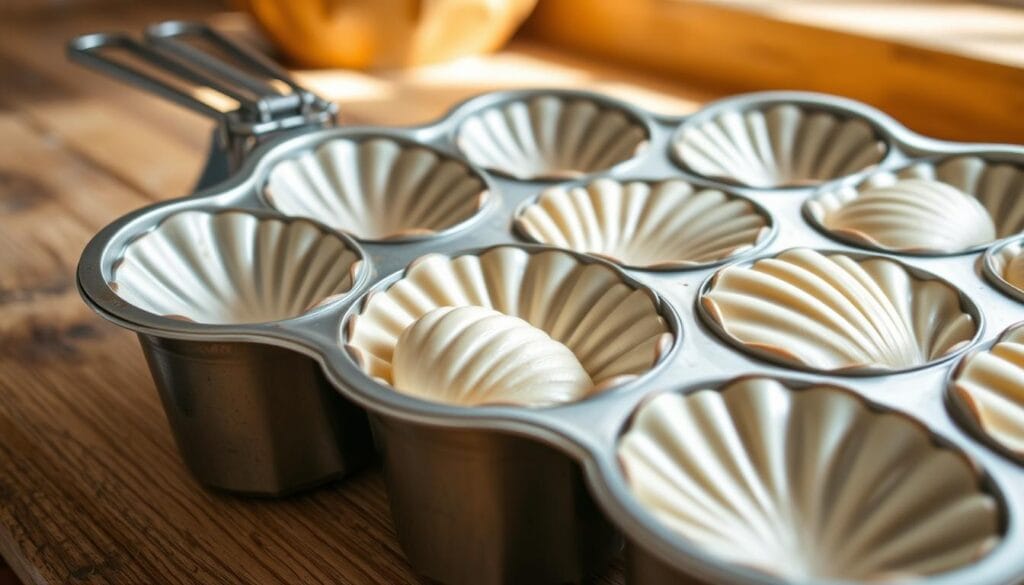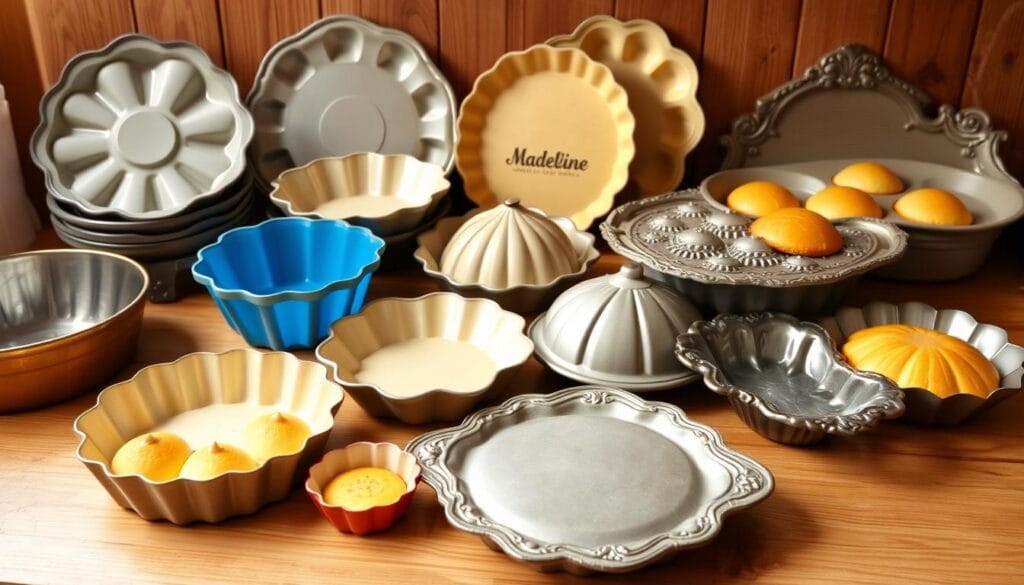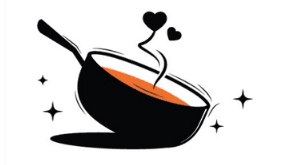Table of Contents
My first time trying French madeleines was magical. Those delicate, shell-shaped cookies had golden edges and a soft crumb. I wondered how they got their perfect shape. As a home baker, I learned the madeleine pan is key to this classic recipe.
Making these French cookies is more than just mixing ingredients. The madeleine pan turns simple batter into those iconic, shell-shaped treats. Whether you’re an experienced baker or new to the kitchen, knowing about madeleine pans can improve your baking.
Before you begin baking, let’s see if this special pan is really needed for perfect madeleines. These cookies will surely impress your loved ones.
Understanding Traditional Madeleine Pans and Their Purpose
In French baking, the traditional madeleine pan is a standout. It’s not just a tool; it’s a key to making real French treats. These have been loved by pastry fans for ages.

The Classic Shell-Shaped Design
The shell-shaped mold is at the heart of making madeleines. It shapes the cakes into their famous scalloped look. These pans come from the Lorraine region of France. They turn simple batter into beautiful, seashell-like pastries.
- Captures the traditional French baking aesthetic
- Creates uniform shell-like pastries
- Ensures consistent baking of each madeleine
How the Pan Affects Texture and Appearance
The pan you choose greatly affects your madeleines. It gives them the signature hump and crisp edges. For bakers, the right pan is key to making them just right.
Traditional vs Modern Madeleine Pans
Classic French baking uses metal pans, but now there are modern options. You can find non-stick and silicone pans for dairy-free madeleines. The important thing is to keep the original shell shape.
“A true madeleine is not just a cake, but a piece of culinary art crafted with precision and passion.” – French Pastry Chef
Different Types of Madeleine Pans Available
Exploring madeleine pan types opens a world of baking molds. These molds are designed to make those iconic shell-shaped treats. The right pan can change your baking and make your dishes better.

Madeleine pans come in many exciting types. Each has its own special features for bakers:
- Oval Shell Pans: The classic design with 6, 12, or 16 wells
- Spherical Shell Pans: Offering 6 or 12 distinctive shell-shaped wells
- Scallop-Shaped Pans: Featuring 12 intricately designed wells
- Heart-Shaped Shell Pans: A romantic twist on the traditional madeleine mold
The material of your baking molds is key. Metal pans, especially carbon steel, spread heat well. Carbon steel pans can handle temperatures up to 428 degrees Fahrenheit, making sure your baked goods turn out right every time.
“The right pan is the secret to creating picture-perfect madeleines!” – Pastry Chef Recommendation
For those who bake without dairy, these pans are perfect. They work great with special ingredients. Your madeleines will keep their elegant shape and soft texture, no matter the recipe.
Pro tip: Chill your pan in the freezer and fill it only 70-80% full. This trick helps your madeleines rise and get that golden-brown edge.
Material Considerations: Metal vs Silicone Pans
Choosing between metal and silicone madeleine pans can make a big difference in your baking. Each material has its own benefits that can enhance your dairy-free desserts.
Carbon Steel Pan Benefits
Carbon steel pans are known for their excellent heat transfer. They offer:
- Superior heat distribution
- Rapid and even cooking
- Durability for long-term use
- Potential for developing a natural non-stick surface
Aluminum Pan Properties
Aluminum pans are light and conduct heat well. They’re great for making delicate desserts because they:
- Quickly respond to temperature changes
- Are light and easy to handle
- Conduct heat moderately
- Are affordable
Silicone Pan Advantages
Silicone madeleine pans are popular for their versatility. They offer:
- Temperature resistance up to 450-500°F
- Dishwasher-safe convenience
- Flexible and easy storage
- BPA-free manufacturing
Pro tip: When using silicone pans, always place them on a sturdy baking sheet for added stability during baking.
The right pan material depends on your baking needs and preferences. It’s all about creating the perfect dairy-free desserts.
Do I Need a Madeleine Pan to Make This Recipe?
Creating the perfect madeleine recipe doesn’t always need a special pan. Traditional madeleine pans have the iconic shell shape. But, home bakers can find creative substitutes for baking.
There are ways to still make delightful treats without a traditional pan:
- Mini muffin tins give a similar small cake feel
- Silicone molds let you shape your treats freely
- Small ramekins can be used as creative alternatives
When baking dairy-free or vegan madeleines, the pan’s flexibility increases. The type of pan can change the texture and look of your treats.
“The essence of a madeleine is not just in its pan, but in its delicate preparation and flavor.”
Here are some pan alternatives for your madeleine recipe:
| Pan Type | Texture Impact | Recommended For |
|---|---|---|
| Mini Muffin Tin | Slightly less crisp edges | Beginner bakers |
| Silicone Mold | Flexible shape options | Creative baking |
| Ramekins | Softer exterior | Experimental recipes |
While other methods can work, a traditional madeleine pan is best for the perfect shell shape and crisp exterior. The secret to success lies in the technique and ingredients, no matter the pan you use.
Essential Features of Quality Madeleine Pans
Choosing the right madeleine pan can change your baking game. The right pan affects the texture and look of these French cookies.
Professional bakers say madeleine pan features are key to perfect treats. Let’s look at what to consider when picking your baking tool.
Temperature Resistance
Your madeleine pan needs to handle high heat. Good pans can handle:
- Oven-safe temperatures up to 450°F
- Aluminized steel construction
- Even heat distribution
Non-stick Properties
Non-stick pans are vital for those shell-shaped madeleines. The right pan means:
- Easy cookie removal
- Silicone coating for easy release
- Less butter or grease needed
| Pan Feature | Performance Detail |
|---|---|
| Cavity Dimensions | 2 x 3 x 0.625 inches |
| Total Cavities | 16 shell-shaped molds |
| Material | Aluminized Steel |
| Non-stick Coating | Silicone |
Size and Capacity Options
Think about your baking needs when picking a pan. Most pro madeleine pans have:
- Many cavity options
- Same pan size
- Works with standard ovens
“The right pan is the secret ingredient to perfect madeleines” – Professional Pastry Chef
Whether making traditional or lactose-free madeleines, a top-notch pan means great results every time.
Proper Care and Maintenance of Your Madeleine Pan
Taking good care of your madeleine pan makes it last longer. It also helps you bake perfect treats every time. This is true whether you’re making dairy-free or egg-free madeleines.
Cleaning your baking pans needs care. Here are the key steps for keeping your madeleine pan in top shape:
- Always hand wash your pan with warm, soapy water
- Use a soft sponge or cloth to prevent scratching
- Avoid abrasive cleaning tools
- Dry completely before storing
Metal madeleine pans need extra care. Before each use, lightly grease with butter and dust with flour. This helps prevent sticking and gives madeleines their crispy outside.
“A well-maintained pan is the secret to perfect madeleines” – French Pastry Experts
For silicone molds, cleaning is a breeze. These pans usually need little effort to clean. Always check the care instructions from the manufacturer.
Pro tip: Keep your madeleine pan in a cool, dry spot. This prevents rust or warping. With the right care, your pan will help you make tasty treats for years.
Alternative Baking Methods Without a Madeleine Pan
Want to make delicious madeleines but don’t have the right pan? No problem! You can still make these tasty French treats with items you probably have at home.
Exploring Mini Muffin Tin Solutions
A mini muffin tin is a great substitute for a madeleine pan. The shape won’t be the same, but the taste will be. Here are some tips:
- Grease the mini muffin tin well to avoid sticking
- Fill each spot about 3/4 full with batter
- Keep an eye on the baking time, as they cook faster
Creative Substitution Options
Looking for madeleine alternatives? You have many fun options:
| Alternative Pan | Texture Characteristics | Recommended Use |
|---|---|---|
| Mini Bundt Pan | Slightly fluted, rounded | Close to traditional shape |
| Tartlet Pans | Shallow, round | Good for bite-sized treats |
| Silicone Baking Mats | Flat, even surface | Easy release, uniform baking |
Understanding Texture Differences
Using different pans for your dairy-free recipe will change the texture. The madeleine hump might not be as noticeable, and the shell-like ridges could be less defined. Embrace the unique character of your homemade treats!
“Baking is about creativity, not perfection.” – Unknown Pastry Chef
No matter the pan you choose, focus on keeping the madeleines’ delicate flavor and light texture. Your dairy substitute can still make a delicious, memorable dessert.
Making Dairy-Free Madeleines: Pan Considerations
Making dairy-free madeleines needs careful attention to your baking pan. The right pan can greatly affect your vegan madeleines’ texture and look.
Choosing the right pan is key when baking lactose-free madeleines. Silicone madeleine pans are great for dairy-free baking because they:
- Release easily without too much grease
- Heat evenly
- Have a non-stick surface perfect for different ingredients
Understanding how pans work with non-traditional ingredients is crucial for dairy-free baking. Here’s a look at different pan options:
| Pan Type | Benefits for Dairy-Free Madeleines | Potential Challenges |
|---|---|---|
| Silicone | Flexible, easy release, non-stick | May need extra support on baking sheet |
| Non-Stick Metal | Even heat, traditional shape | Needs careful greasing |
| Ceramic | Keeps heat well | Can be heavy, might bake unevenly |
Pro tip: Always preheat your chosen pan for even baking of your dairy-free madeleines. The right pan can make alternative baking a joy.
“Choosing the perfect pan is the first step to creating magical dairy-free madeleines that everyone will love.” – Pastry Chef Elena Rodriguez
Your pan is more than a baking tool—it’s the start of your dairy-free cooking journey. Try out different materials to find your ideal madeleine-making partner.
Tips for Perfect Madeleines Regardless of Pan Choice
Making perfect madeleines is more than just the right pan. These French treats need precision and special tips for that golden shell and soft texture.
- Use room temperature eggs for a light, airy texture
- Brown your butter for a nutty flavor
- Chill both the pan and batter before baking for the classic madeleine bump
- Try different pans to find your favorite finish
“The secret to perfect madeleines lies in the details of preparation and technique.”
Different pans change your madeleines. Metal pans give crisp edges, while silicone pans make chocolate dipping easier.
| Pan Material | Texture Benefit | Release Ease |
|---|---|---|
| Carbon Steel | Crisp Edges | Moderate |
| Aluminum | Even Heating | Good |
| Silicone | Soft Edges | Excellent |
Practice makes perfect. Every try gets you closer to making amazing madeleines that will wow anyone.
Conclusion
Your madeleine baking adventure doesn’t have to be limited by specialized equipment. While a traditional madeleine pan creates the iconic shell shape, creative bakers can craft delightful French cookies using alternative baking equipment. The key is understanding techniques that elevate your madeleine baking skills.
Exploring different baking methods opens up possibilities for making delectable treats. Whether you’re preparing classic or dairy-free madeleines, your choice of baking equipment significantly impacts the final result. Select pans that offer consistent heat distribution and non-stick properties to ensure perfect texture and appearance.
Remember that mastering madeleine baking is about technique, ingredient quality, and passion. Experimenting with various pans and methods will help you develop your unique approach to these delicate French delicacies. Your culinary creativity can transform simple baking equipment into a pathway for creating memorable, delicious treats that delight both family and friends.

